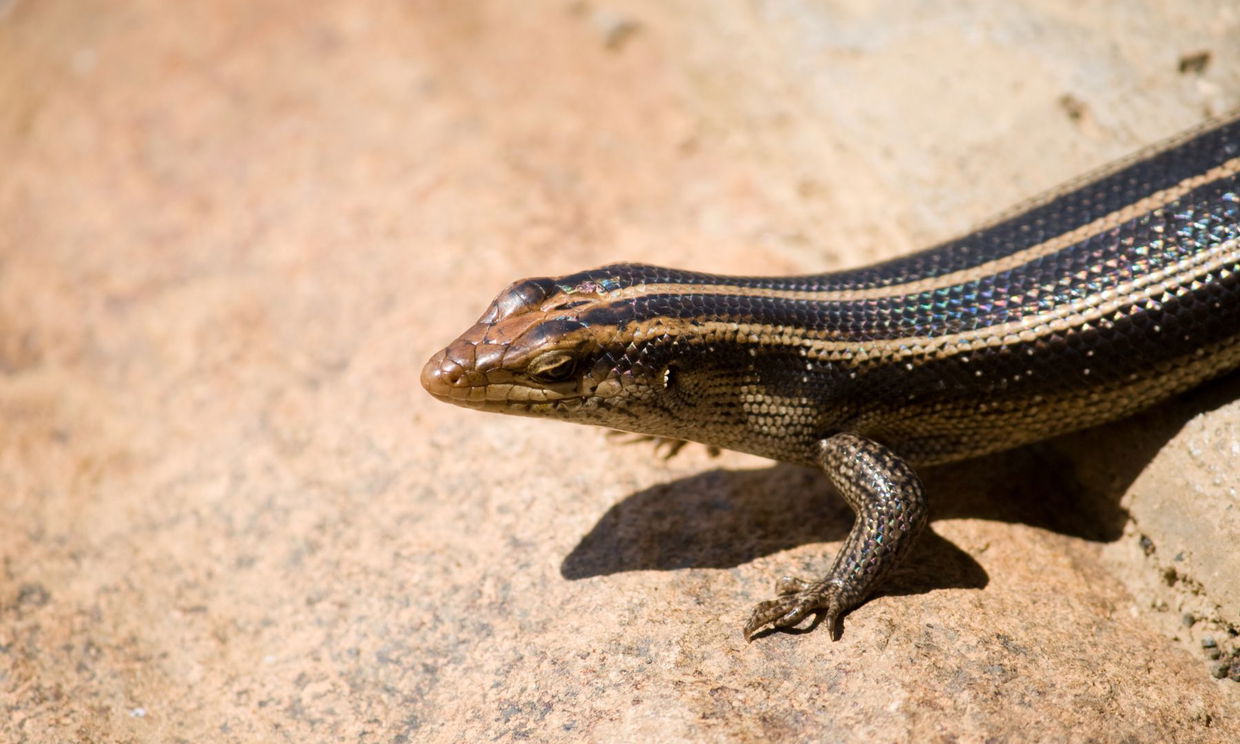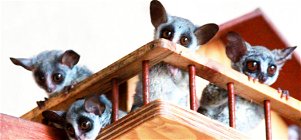Africa's skies are home to a diverse array of birds of prey, each with unique adaptations for hunting and playing crucial roles in their ecosystems. Species like the African Fish Eagle and Peregrine Falcon showcase the continent's avian diversity and evolutionary marvels, while vultures, often overlooked, serve as vital ecological stewards.
The Masters of Survival: Geckos, Skinks, Chameleons, and Lizards of the African Bushveld
Explore the reptiles of Kruger National Park and Marloth Park. Discover geckos, skinks, and chameleons in South Africa’s bushveld habitats.
South Africa is renowned for its vibrant landscapes and diverse ecosystems, and few places showcase this better than the iconic Kruger National Park and its surrounding areas like Marloth Park. These regions are home to an array of remarkable reptiles, each adapted to thrive in the bushveld’s dynamic environment. From the Spotted Thick-Toed Gecko to the Wahlberg’s Velvet Gecko, these small yet extraordinary creatures play a vital role in maintaining ecological balance. Whether you’re exploring the vast terrains of Kruger or the intimate wildlife sanctuary of Marloth Park, these reptiles offer a glimpse into nature’s ingenuity.

Spotted Thick-Toed Gecko: The Stealthy Night Stalker
The Spotted Thick-Toed Gecko (Pachydactylus maculatus) is a subtle yet fascinating inhabitant of the South African bushveld. Its dappled skin mimics the rocky surfaces of its environment, allowing it to blend seamlessly with its surroundings.
Habitat
This gecko is most commonly found in rocky terrains and semi-arid regions of Kruger National Park and Marloth Park. By day, it seeks shelter in crevices, conserving moisture and avoiding predators. At night, it emerges to hunt, taking advantage of the cooler temperatures.
Behavior
A master of stealth, this gecko relies on its keen eyesight to spot prey in the dark. It hunts with precision, often targeting insects that are abundant in Kruger and Marloth’s diverse ecosystems.
Unique Trait
Its adhesive toe pads allow it to climb smooth surfaces and vertical rock faces effortlessly, a critical adaptation for navigating its rugged habitat.
Ecological Role
The Spotted Thick-Toed Gecko is a natural pest controller, feeding on insects that could otherwise disrupt the balance of these ecosystems. Its role highlights the interconnectedness of all life within the bushveld.
To learn about other fascinating nocturnal creatures, read our blog on The Bats of Kruger National Park.

Striped Skink: The Sleek Speedster
The Striped Skink (Trachylepis striata) is a common yet captivating sight in the bushveld. Whether basking on sunlit rocks in Kruger National Park or scurrying across pathways in Marloth Park, its shimmering stripes add a touch of brilliance to the environment.
Habitat
This adaptable reptile thrives in a variety of environments, including the savannas and rocky outcrops of Kruger and the more intimate landscapes of Marloth. It often shelters under logs or stones, making use of the bushveld’s natural features.
Behavior
An active hunter, the Striped Skink spends its days chasing insects and other small prey. Its quick reflexes and agile movements make it one of the bushveld’s most efficient predators.
Unique Trait
The skink’s water-repellent scales reduce water loss and allow it to move with incredible speed, helping it evade predators and navigate its habitat effectively.
Ecological Role
By preying on insects and serving as food for birds and larger reptiles, the Striped Skink maintains balance in the food web of South Africa’s iconic parks.

Flap Neck Chameleon: The Bushveld’s Color-Changing Archer
With its swiveling eyes and mesmerizing ability to change color, the Flap Neck Chameleon (Chamaeleo dilepis) is one of the bushveld’s most intriguing residents. Often spotted in the wooded areas of Marloth Park or Kruger’s riverine habitats, it epitomizes the slow and deliberate pace of life in the wild.
Habitat
The Flap Neck Chameleon prefers wooded areas and dense vegetation, often near water sources. In Kruger National Park, they are frequently found in acacia trees, while in Marloth Park, they can be spotted in gardens and shrubs.
Behavior
This chameleon is a solitary and stealthy hunter. Its ability to remain motionless for long periods allows it to ambush prey, often insects that are abundant in the bushveld.
Unique Trait
Its long, sticky tongue is a marvel of nature, capable of extending up to twice its body length to snare prey. This adaptation ensures its survival in a competitive environment.
Ecological Role
The Flap Neck Chameleon plays a key role in pest control, feeding on locusts and grasshoppers that could otherwise damage vegetation. Its presence is a sign of a healthy, balanced ecosystem.
Learn more about other predators in our blog on The Enigmatic Serval.

Ornate Sandveld Lizard: The Jewel of the Bushveld
The Ornate Sandveld Lizard (Nucras ornata) is a vibrant splash of color in the otherwise muted tones of the bushveld. With its striking patterns and agile movements, it is a favorite among wildlife enthusiasts exploring Kruger or Marloth Park.
Habitat
This lizard thrives in sandy plains and scrublands, where its bright coloration helps it blend into the environment. In Kruger National Park, it often shelters under rocks or burrows in loose soil, while in Marloth Park, it is a frequent visitor to gardens.
Behavior
A diurnal creature, the Ornate Sandveld Lizard is most active during the day. It is territorial and can often be seen basking in the sun or darting after insects.
Unique Trait
Its colorful patterns serve not only as camouflage but also as a visual signal during courtship and territorial disputes.
Ecological Role
As an insectivore, the lizard helps control populations of harmful insects. Its role as both predator and prey makes it an essential part of the bushveld’s intricate food web.

Wahlberg’s Velvet Gecko: The Velvet-Clad Climber
Graceful and mysterious, Wahlberg’s Velvet Gecko (Homopholis wahlbergii) is a quiet but vital presence in the bushveld. Its soft, velvety skin and silent movements make it a favorite among reptile enthusiasts in Marloth Park and Kruger.
Habitat
This gecko thrives in rocky areas and wooded regions, often clinging to tree trunks or hiding under bark. It is frequently found in the transitional zones between Marloth Park and Kruger, where its adaptability ensures its survival.
Behavior
Wahlberg’s Velvet Gecko is nocturnal, emerging after dusk to hunt insects. It is territorial and will defend its chosen area using vocalizations and displays.
Unique Trait
Its velvety skin is not just a tactile wonder; it aids in moisture retention, an essential feature in the arid bushveld environment.
Ecological Role
As a predator of moths, beetles, and other pests, this gecko helps maintain the balance of insect populations, making it a crucial part of the ecosystem.
Experience the Reptile Wonders of the Bushveld
Whether you’re wandering through the legendary Kruger National Park or relaxing in Marloth Park’s serene landscapes, the reptiles of South Africa are bound to captivate you. These creatures are more than just inhabitants—they are guardians of the bushveld, maintaining balance and enriching biodiversity.
At Needles Lodge, we offer you the chance to explore this fascinating world firsthand. From guided tours in Kruger to close encounters with wildlife in Marloth, every stay promises unforgettable experiences. To deepen your understanding of the bushveld, read our blogs on The Fork-Tailed Drongo and The Cape Porcupine.
Ready to uncover the secrets of the bushveld’s remarkable reptile residents?
Book your stay at Needles Lodge today and immerse yourself in the wonders of South Africa’s wildlife! Whether it’s exploring Kruger National Park’s diverse habitats or encountering the fascinating creatures of Marloth Park, every moment promises adventure and discovery.
Further Reading
Needles Lodge offers an unforgettable South African adventure, with a variety of activities perfect for families. Located near Kruger National Park, it provides diverse safari experiences, including full-day and sunrise drives. Guests can also enjoy unique activities like tiger fishing, scenic tours along the Panorama Route, cultural trips to Eswatini and Mozambique, and tranquil nature walks in Marloth Park. The lodge is an ideal base for exploring the region's natural beauty and...
Did you know that the Cape Porcupine is the largest rodent in Southern Africa? This species is found throughout southern and central Africa, including South Africa, Kenya, Uganda, and the Congo. And as the official Needles Lodge logo it’s one of our favourite animals!






Share This Post